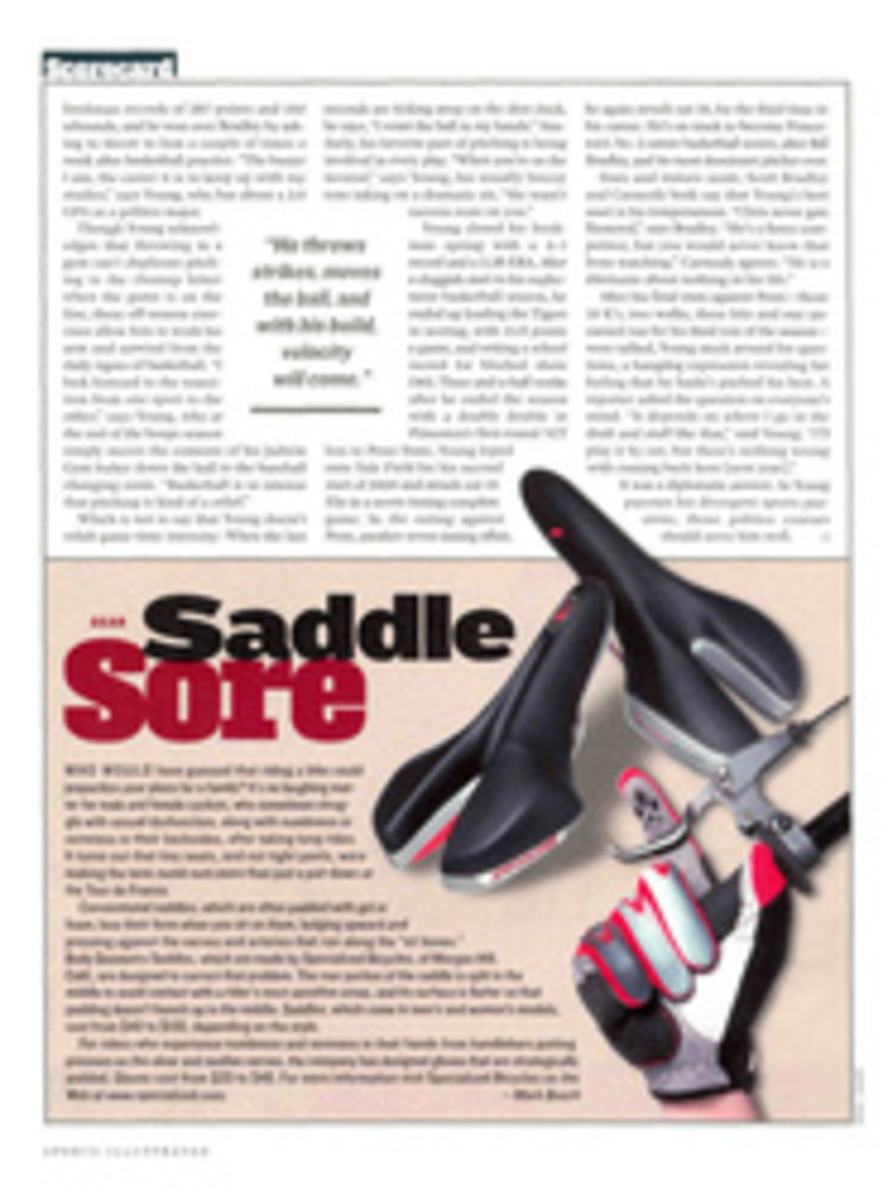
Setting a Course for Sydney Tom Brown's Olympic quest depends on two strong legs, one of them carbon
It's easy to spot Tom Brown in the water. He's the skinny guy
way out in front of the sailboat pack, finding the breeze no one
else does, the sun glinting off his black prosthetic leg. "It's
carbon," he says with a wink. "Same stuff the spinnaker pole's
made out of."
Brown, 40, of Mount Desert Island, Maine, is a water-bound Tom
Sawyer: tall and lanky, with a sly grin and a thousand stories,
most of which are true. He's happiest in the choppy waters off
Mount Desert. Arctic terns and harbor seals keep him company as
he glides past the barnacled remains of his great-grandfather's
dance hall at the end of an old pier, past Bear Island lighthouse
to Great Cranberry Island and beyond. He knows every underwater
ledge, every osprey nest, the changing patterns of the tides.
"The water is alive," says Brown. "I hate it if I can't see it
every day. It's such a big part of me."
Brown has run with the wind all his life. At 10 he was told he
would lose his right leg to bone cancer and was given only a
one-in-five chance of survival. On the night before the surgery,
the youngster clipped the toenails of his right foot as a
memento, put them in a matchbox and sprinted down the hospital
corridor one last time.
He's racing still. Today Brown is a world-class sailor of
Solings, the three-person keelboats that are the largest boats to
sail in Olympic competition. He has set his sights on Sydney. To
qualify for the Olympics--Brown has already qualified for the
Paralympics in the 2.4-meter class--he must compete against
able-bodied sailors at the trials in San Francisco on June 1-11.
Qualifying races for the eight spots in San Francisco were held
last week in Florida, and Brown finished fifth overall. Only one
boat will make it to Sydney. It's a long shot, but as Brown's
father, Buddy, says, "How the hell can they tell you you can't do
it if you haven't tried yet?"
The water is just down the hill from Brown's home, beckoning.
Most days, though, he works at his family's hardware store, F.T.
Brown's, in the tidy village of Northeast Harbor. Tom and his
wife, Kelly, 26, live over the store, as his parents did before
them. "Usually, all I do in the morning is get in the leg,
because my sneaker and pants are already on it, and go to work,"
he says.
F.T. Brown's is an old-fashioned place, crammed to the rafters
with marine gear, Dominican cigars, Radio Flyer red wagons and
overhead display cases of shorebirds shot and stuffed by Brown's
great-great-grandfather. Tom is out back, in a warehouse attached
to the store, wearing tattered blue jeans, running shoes and a
windbreaker. He's pouring epoxy into a cracked rudder, hoping to
make it usable in his next race. Brown has been handy since he
was a kid, when he learned to repair the prosthetic legs he was
constantly banging up and outgrowing.
He keeps three of them as trophies on a gun rack upstairs. Made
with leather straps and tan foam, they're flaking and battered,
patched together with sail twine and duct tape. "They've been
through hell," Brown says proudly. He points to another leg that
leans against a wall. "That hydraulic one didn't work until I
fell overboard in St. Thomas in 1984," he says. "After that it
worked like a dream."
Down at the harbor Brown hoists himself aboard his boat and
inspects the rigging. His left leg and his strong, sinewy arms do
most of the work, while the carbon leg gracefully swings and
pivots. "I need a leg that can go overboard and I can go with
it," he says. "Something light that I can throw around quick."
Losing a leg did not slow Brown down very much. Buddy got him on
a bicycle right after surgery. Tom learned to walk by practicing
in front of the living room mirror, and before long he was
playing pickup football and basketball and pitching for his
Little League baseball team.
But the amputation, his doctor told him, was "the easy part. The
hard part's coming up." For two nightmarish years, until he was
12, Tom had chemotherapy once every week; every six weeks he'd
get the burning shots for seven straight days. Hoping to cheer
him up, one of "the summer ladies," as his mother, Becky, calls
them, took him racing in a small Mercury, a 15-foot keelboat.
They won the race--and he was hooked. "The open ocean was
something I could escape to," Brown says. "There were so many
things I couldn't control. But when I looked out at the water, I
could sense what was happening. I could see where the wind was,
what was happening with the tide."
He started racing different boats, moving from Mercurys to larger
J-24s and finally to the 27-foot Soling, which he says is easy
for him to race because "you don't have to be a gymnast." Not
that it doesn't get tricky at times. Lines often get wrapped
around Brown's prosthetic leg, leaving him strapped to his boat.
"You know how Ahab got all wrapped up around the whale?" he says.
"That's what it looks like."
As Brown advances toward the trials, there's a slightly
detectable buzz in the air, even though, as Buddy says, "You have
to remember you're Down East here. You don't dare get too
excited." But Brown's life has never seemed more hopeful. Married
in December, he has Kelly, who has added stability to his life; a
baby daughter, Molly, born last Thursday; and a clean shot at the
Olympics--if only he can raise the money.
That has been his biggest handicap. The American Cancer Society
has given its endorsement to Brown but no funds. His
competitors, who compete nearly full time, are backed by the
likes of PaineWebber and United Airlines. Brown, by contrast,
has no corporate sponsors and is rarely able to hire a crew and
travel to regattas. His backing comes entirely from private
donations. Until recently, he had to make do with a broken
rudder and old sails.
He's nothing if not resourceful. This year's America's Cup races,
held in Auckland, New Zealand, had live Internet coverage
detailing each tack and wind shift. Using a software program on
his computer, Brown kept a detailed analysis of each race. "It's
hard not to be able to race all the time," says Kelly, "but he
can learn tactics even if he's not there physically."
Brown figures that his disability may even give him a competitive
edge. Some years back, when his team was a few pounds overweight
to qualify for a J-24 race, one crew member had to strip to his
underwear. Brown simply slipped off his prosthesis. "Now, that
was an advantage," he says.
Brown knows his Olympic quest may prove elusive. But if he
doesn't make the Games this year, he says he'll try again in
2004. He wants very much to win--for himself, for his family and
for those who have allowed disabilities to cloud their dreams.
"If people are feeling sorry for themselves and they see me
racing a sailboat, well, maybe they'll get with the program,"
says Brown. "If you lose a limb, you just keep on going."
COLOR PHOTO: BOB ROSATO
"That hydraulic leg didn't work until I fell overboard with it
in St. Thomas."
"The water is alive. I hate it if I can't see it every day. It's
such a big part of me."

